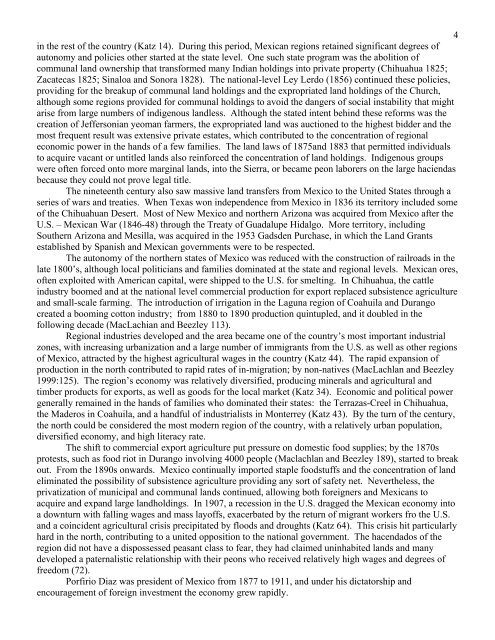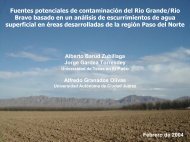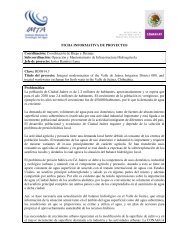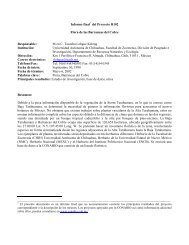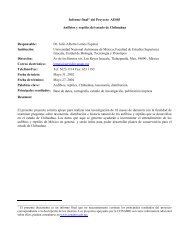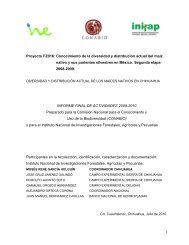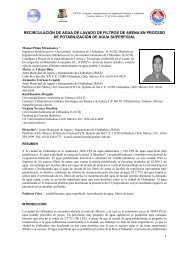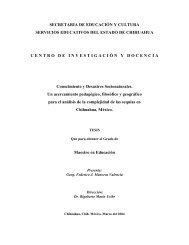land use and land tenure change in the - El Colegio de Chihuahua
land use and land tenure change in the - El Colegio de Chihuahua
land use and land tenure change in the - El Colegio de Chihuahua
You also want an ePaper? Increase the reach of your titles
YUMPU automatically turns print PDFs into web optimized ePapers that Google loves.
4<strong>in</strong> <strong>the</strong> rest of <strong>the</strong> country (Katz 14). Dur<strong>in</strong>g this period, Mexican regions reta<strong>in</strong>ed significant <strong>de</strong>grees ofautonomy <strong>and</strong> policies o<strong>the</strong>r started at <strong>the</strong> state level. One such state program was <strong>the</strong> abolition ofcommunal <strong>l<strong>and</strong></strong> ownership that transformed many Indian hold<strong>in</strong>gs <strong>in</strong>to private property (<strong>Chihuahua</strong> 1825;Zacatecas 1825; S<strong>in</strong>aloa <strong>and</strong> Sonora 1828). The national-level Ley Lerdo (1856) cont<strong>in</strong>ued <strong>the</strong>se policies,provid<strong>in</strong>g for <strong>the</strong> breakup of communal <strong>l<strong>and</strong></strong> hold<strong>in</strong>gs <strong>and</strong> <strong>the</strong> expropriated <strong>l<strong>and</strong></strong> hold<strong>in</strong>gs of <strong>the</strong> Church,although some regions provi<strong>de</strong>d for communal hold<strong>in</strong>gs to avoid <strong>the</strong> dangers of social <strong>in</strong>stability that mightarise from large numbers of <strong>in</strong>digenous <strong>l<strong>and</strong></strong>less. Although <strong>the</strong> stated <strong>in</strong>tent beh<strong>in</strong>d <strong>the</strong>se reforms was <strong>the</strong>creation of Jeffersonian yeoman farmers, <strong>the</strong> expropriated <strong>l<strong>and</strong></strong> was auctioned to <strong>the</strong> highest bid<strong>de</strong>r <strong>and</strong> <strong>the</strong>most frequent result was extensive private estates, which contributed to <strong>the</strong> concentration of regionaleconomic power <strong>in</strong> <strong>the</strong> h<strong>and</strong>s of a few families. The <strong>l<strong>and</strong></strong> laws of 1875<strong>and</strong> 1883 that permitted <strong>in</strong>dividualsto acquire vacant or untitled <strong>l<strong>and</strong></strong>s also re<strong>in</strong>forced <strong>the</strong> concentration of <strong>l<strong>and</strong></strong> hold<strong>in</strong>gs. Indigenous groupswere often forced onto more marg<strong>in</strong>al <strong>l<strong>and</strong></strong>s, <strong>in</strong>to <strong>the</strong> Sierra, or became peon laborers on <strong>the</strong> large haciendasbeca<strong>use</strong> <strong>the</strong>y could not prove legal title.The n<strong>in</strong>eteenth century also saw massive <strong>l<strong>and</strong></strong> transfers from Mexico to <strong>the</strong> United States through aseries of wars <strong>and</strong> treaties. When Texas won <strong>in</strong><strong>de</strong>pen<strong>de</strong>nce from Mexico <strong>in</strong> 1836 its territory <strong>in</strong>clu<strong>de</strong>d someof <strong>the</strong> <strong>Chihuahua</strong>n Desert. Most of New Mexico <strong>and</strong> nor<strong>the</strong>rn Arizona was acquired from Mexico after <strong>the</strong>U.S. – Mexican War (1846-48) through <strong>the</strong> Treaty of Guadalupe Hidalgo. More territory, <strong>in</strong>clud<strong>in</strong>gSou<strong>the</strong>rn Arizona <strong>and</strong> Mesilla, was acquired <strong>in</strong> <strong>the</strong> 1953 Gads<strong>de</strong>n Purchase, <strong>in</strong> which <strong>the</strong> L<strong>and</strong> Grantsestablished by Spanish <strong>and</strong> Mexican governments were to be respected.The autonomy of <strong>the</strong> nor<strong>the</strong>rn states of Mexico was reduced with <strong>the</strong> construction of railroads <strong>in</strong> <strong>the</strong>late 1800’s, although local politicians <strong>and</strong> families dom<strong>in</strong>ated at <strong>the</strong> state <strong>and</strong> regional levels. Mexican ores,often exploited with American capital, were shipped to <strong>the</strong> U.S. for smelt<strong>in</strong>g. In <strong>Chihuahua</strong>, <strong>the</strong> cattle<strong>in</strong>dustry boomed <strong>and</strong> at <strong>the</strong> national level commercial production for export replaced subsistence agriculture<strong>and</strong> small-scale farm<strong>in</strong>g. The <strong>in</strong>troduction of irrigation <strong>in</strong> <strong>the</strong> Laguna region of Coahuila <strong>and</strong> Durangocreated a boom<strong>in</strong>g cotton <strong>in</strong>dustry; from 1880 to 1890 production qu<strong>in</strong>tupled, <strong>and</strong> it doubled <strong>in</strong> <strong>the</strong>follow<strong>in</strong>g <strong>de</strong>ca<strong>de</strong> (MacLachian <strong>and</strong> Beezley 113).Regional <strong>in</strong>dustries <strong>de</strong>veloped <strong>and</strong> <strong>the</strong> area became one of <strong>the</strong> country’s most important <strong>in</strong>dustrialzones, with <strong>in</strong>creas<strong>in</strong>g urbanization <strong>and</strong> a large number of immigrants from <strong>the</strong> U.S. as well as o<strong>the</strong>r regionsof Mexico, attracted by <strong>the</strong> highest agricultural wages <strong>in</strong> <strong>the</strong> country (Katz 44). The rapid expansion ofproduction <strong>in</strong> <strong>the</strong> north contributed to rapid rates of <strong>in</strong>-migration; by non-natives (MacLachlan <strong>and</strong> Beezley1999:125). The region’s economy was relatively diversified, produc<strong>in</strong>g m<strong>in</strong>erals <strong>and</strong> agricultural <strong>and</strong>timber products for exports, as well as goods for <strong>the</strong> local market (Katz 34). Economic <strong>and</strong> political powergenerally rema<strong>in</strong>ed <strong>in</strong> <strong>the</strong> h<strong>and</strong>s of families who dom<strong>in</strong>ated <strong>the</strong>ir states: <strong>the</strong> Terrazas-Creel <strong>in</strong> <strong>Chihuahua</strong>,<strong>the</strong> Ma<strong>de</strong>ros <strong>in</strong> Coahuila, <strong>and</strong> a h<strong>and</strong>ful of <strong>in</strong>dustrialists <strong>in</strong> Monterrey (Katz 43). By <strong>the</strong> turn of <strong>the</strong> century,<strong>the</strong> north could be consi<strong>de</strong>red <strong>the</strong> most mo<strong>de</strong>rn region of <strong>the</strong> country, with a relatively urban population,diversified economy, <strong>and</strong> high literacy rate.The shift to commercial export agriculture put pressure on domestic food supplies; by <strong>the</strong> 1870sprotests, such as food riot <strong>in</strong> Durango <strong>in</strong>volv<strong>in</strong>g 4000 people (Maclachlan <strong>and</strong> Beezley 189), started to breakout. From <strong>the</strong> 1890s onwards. Mexico cont<strong>in</strong>ually imported staple foodstuffs <strong>and</strong> <strong>the</strong> concentration of <strong>l<strong>and</strong></strong>elim<strong>in</strong>ated <strong>the</strong> possibility of subsistence agriculture provid<strong>in</strong>g any sort of safety net. Never<strong>the</strong>less, <strong>the</strong>privatization of municipal <strong>and</strong> communal <strong>l<strong>and</strong></strong>s cont<strong>in</strong>ued, allow<strong>in</strong>g both foreigners <strong>and</strong> Mexicans toacquire <strong>and</strong> exp<strong>and</strong> large <strong>l<strong>and</strong></strong>hold<strong>in</strong>gs. In 1907, a recession <strong>in</strong> <strong>the</strong> U.S. dragged <strong>the</strong> Mexican economy <strong>in</strong>toa downturn with fall<strong>in</strong>g wages <strong>and</strong> mass layoffs, exacerbated by <strong>the</strong> return of migrant workers fro <strong>the</strong> U.S.<strong>and</strong> a co<strong>in</strong>ci<strong>de</strong>nt agricultural crisis precipitated by floods <strong>and</strong> droughts (Katz 64). This crisis hit particularlyhard <strong>in</strong> <strong>the</strong> north, contribut<strong>in</strong>g to a united opposition to <strong>the</strong> national government. The hacendados of <strong>the</strong>region did not have a dispossessed peasant class to fear, <strong>the</strong>y had claimed un<strong>in</strong>habited <strong>l<strong>and</strong></strong>s <strong>and</strong> many<strong>de</strong>veloped a paternalistic relationship with <strong>the</strong>ir peons who received relatively high wages <strong>and</strong> <strong>de</strong>grees offreedom (72).Porfirio Diaz was presi<strong>de</strong>nt of Mexico from 1877 to 1911, <strong>and</strong> un<strong>de</strong>r his dictatorship <strong>and</strong>encouragement of foreign <strong>in</strong>vestment <strong>the</strong> economy grew rapidly.


